“So, You Say You Want to Work With Dogs…” – Part 4
You Got the Job! You did it! You received an employment offer and you accepted it. You are starting your new adventure working with dogs. Do you feel confident or confused, ready or apprehensive,…
Sit. Stay. Read.
You Got the Job! You did it! You received an employment offer and you accepted it. You are starting your new adventure working with dogs. Do you feel confident or confused, ready or apprehensive,…
You Got the Job!
You did it! You received an employment offer and you accepted it. You are starting your new adventure working with dogs. Do you feel confident or confused, ready or apprehensive, excited or scared? It’s natural to feel a little bit of all of these. Here are some tips on how to make your transition smooth, productive and rewarding for you, your new employer and the dogs.
What to Expect…
At a minimum, your employer will expect you to:
Note that “Learn” is the operative word. No one expects you to “know” everything in the early days of your employment. Employers expect you to make daily progress on the basics above. They are aware that progress takes time and repetition and that you will make mistakes on occasion. Their goal is for you to become trained in their system and to improve. In order to do this efficiently, employers also expect you to:
What to Avoid…
Just as with an interview, if you want the job, you need to show up when you said you would. Avoid changing your schedule early on. If your job is a priority, your schedule must be as well. Avoid being over-tired or unkempt when you get to work. It’s hard to remember new things when you are exhausted and hard to be taken seriously if you don’t appear to be eager and ready to go.
Avoid too much personal conversation with the staff, clients and dogs. You can still be yourself and you can still be friendly. But if clients and staff can hear you, keep it professional. This means NO CELL PHONE CONVERSATIONS, TEXTING, IM’s, FB POSTS, TWEETs, EMAILS, ON-LINE SHOPPING, etc., while working. Do this on your own time. Don’t assume your employer doesn’t care or that she doesn’t see you doing it. You need to focus fully on your new job. If your employer needs you to use your electronic devices for work purposes, she will tell you this during your training.
 How to Prepare…
How to Prepare…
Be sure to confirm your schedule and the dress code with your employer before your fist day. Learn as much as you can about the company and the culture before your first shift. Read their brochures and any articles or reviews that have been written about them. Check out their website and social media groups. Contact any friends you know who use their services. Fill your calendar around your new work schedule. Do not try to re-schedule work around your other appointments. Allow enough time to travel to work even if there is traffic.
How to Act…
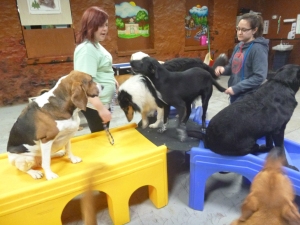 The best way to start any new adventure is to follow the golden rule. Treat others the way you would like to be treated. Communicate clearly. You should always be a little early, so you’re ready to start on time or provide extra help if needed.
The best way to start any new adventure is to follow the golden rule. Treat others the way you would like to be treated. Communicate clearly. You should always be a little early, so you’re ready to start on time or provide extra help if needed.
If you have a true emergency call your employer as far in advance as possible. Listen more than you speak in the beginning. Try not to be defensive if someone offers constructive criticism. Try to understand the reason for the procedure or policy that’s in place. If you don’t know, ask questions until you do.
Remember that at work, the whole is greater than the sum of its parts. Clients, dogs and co-workers are depending on you when you are on the clock. Working together toward the same goals is key for any business to thrive.
Congratulations and best wishes for success in your new endeavors with dogs!
Breaking Into the Field…
You’ve made your decision. You know you want to work with dogs, build your knowledge, gain experience and get paid. You have convinced yourself, now you must convince a prospective employer that you are a worthy candidate. For many great dog professionals, this is a daunting task. First, you must do it on paper. You need a resume. Include the basics: Contact Information, Education, Awards/Honors, Certifications and Work Experience.
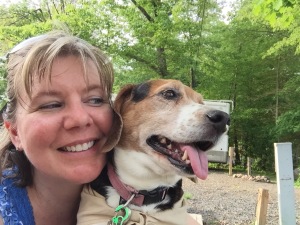 The employer needs to be able to learn something about you from this piece of paper. Even if you don’t have much experience, highlight any that is relevant. For example, if you were in charge of your pets’ care at home or if you worked as a pet sitter even just for family or neighbors, include it. If you have room, you can include Volunteer/Community Service Activities and Hobbies, particularly if they are related to animal care or welfare.
The employer needs to be able to learn something about you from this piece of paper. Even if you don’t have much experience, highlight any that is relevant. For example, if you were in charge of your pets’ care at home or if you worked as a pet sitter even just for family or neighbors, include it. If you have room, you can include Volunteer/Community Service Activities and Hobbies, particularly if they are related to animal care or welfare.
If your work experience is not obviously relevant or your resume is already a full page or two long, include a targeted cover letter. This is where you explain your passion for dog care, your work ethic and commitment, exemplified by your grades and productivity to date. Highlight your customer service skills, your patience and your desire to learn.
Some employers may prefer an eager but admittedly “green” person over one with more experience. Employers like new staff members who are trainable and open to their policies and procedures. Make sure your resume is neat, legible, and grammatical. If you are responding to a classified ad or job post, be sure to complete any other forms the employer requests such as applications or questionnaires. If possible, send your paperwork to the employer electronically.
You’ve Been Called for an Interview; Now What?
An employer read your materials and contacted you for an interview. What’s your next step?
Considerations…
 During the interview, ask questions. Get a feel for the culture of the business, the team and your specific duties. Find out if the company has a dress code and what you should wear to work. Will you be working directly with the dogs, with the customers or both? What is their dog training and dog care philosophy? Take a tour of the facility. Is it spacious, clean and safe for the staff, the dogs and the clients? Find out if there is room to grow in the position and/or the company. Do they offer training? Are their any incentives? What are the hours like? How was your drive to the facility and how might it be during your work hours?
During the interview, ask questions. Get a feel for the culture of the business, the team and your specific duties. Find out if the company has a dress code and what you should wear to work. Will you be working directly with the dogs, with the customers or both? What is their dog training and dog care philosophy? Take a tour of the facility. Is it spacious, clean and safe for the staff, the dogs and the clients? Find out if there is room to grow in the position and/or the company. Do they offer training? Are their any incentives? What are the hours like? How was your drive to the facility and how might it be during your work hours?
Finding a fit with your employer is a two-way street. How do you feel about everything you’ve heard and seen? If you have misgivings about what you will be doing or where you will be doing it, then speak up or keep looking. However, if you can see yourself in this new position, then take the next step. Find out the employer’s timeline for making a decision before you leave the interview. Be sure to keep in touch through a quick thank you note immediately after the interview and a follow up email or call if you don’t hear back within the time they specified.
If, in the meantime, you find a better fit, let the employer know as soon as possible. Always end your encounter on a positive note; you never know, you may want to try again later if you didn’t get a position this time.
Stay Tuned…
Return to our next blog post for some tips on what to expect when you get the job.
“So, You Say You Want to Work With Dogs…” – Part 4
No matter which dog-related profession you choose, the best way to find your niche is to get some direct dog experience, beyond your relationship with your own pets in your own home.
There are several ways to do this which require little or no preparation:
Real experience, paid training…
Working for a dog service professional is the best way to prepare for any dog-related professional category. Whether it is a grooming, training, day care, boarding or retail facility, you will be trained and paid to work with dogs of different sizes, breeds and owners.
If you want to spend time with healthy dogs, consider working in a boarding kennel or doggie day care center. These jobs are often available to those with no previous experience, and training is done on-site. Day care workers supervise playtime for dogs that stay for the day. Kennel attendants care for and clean up after dogs that are boarding for days to weeks. You’ll have a set schedule and pay check. With experience, one can eventually become a manager or business owner.
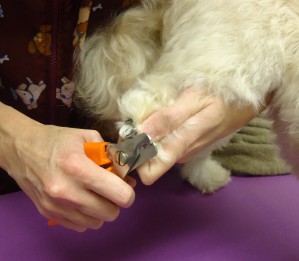 If you like making dogs smell nice and look pretty, work with a professional dog groomer. They can teach you as they groom and advise on where to get additional training.
If you like making dogs smell nice and look pretty, work with a professional dog groomer. They can teach you as they groom and advise on where to get additional training.
Working with a dog trainer requires an understanding of the canine mind, an ability to educate, and a great deal of patience. Dog trainers teach commands from basic to advanced and help dog owners teach these commands to their own dogs.
Dog owners want quality food and products for their dogs. They also want choices with little or no experience, you can work in a pet supply store, meeting all kinds of dogs and learning about all types of dog foods, treats, accessories and toys.
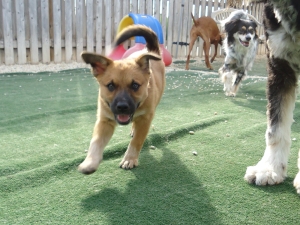 Now imagine all the excitement, fun and learning experiences you could have at a facility that offers multiple services under one roof! You will become acquainted with occasional dog misbehavior and some messy hard work. You will also learn a skill all dog professionals require: learning to deal with owners who encourage misbehavior and fail to follow through training lessons! You will be accountable for the safety and well being of your client’s pets and in doing so find your specialty.
Now imagine all the excitement, fun and learning experiences you could have at a facility that offers multiple services under one roof! You will become acquainted with occasional dog misbehavior and some messy hard work. You will also learn a skill all dog professionals require: learning to deal with owners who encourage misbehavior and fail to follow through training lessons! You will be accountable for the safety and well being of your client’s pets and in doing so find your specialty.
Consider Cold Nose Lodge!
We are ALWAYS looking for passionate, committed people who can deliver exceptional service to our clients and exceptional care to their pets. We are a premier luxury dog center. We provide a safe , clean environment for dogs’ physical and mental stimulation, socialization and training under the watchful eyes of our caring, professional staff. We strive to reduce behavior problems and improve dogs’ relationships with people. Our boutique supplies the best in dog food, treats, toys and fashion. If this sounds like you, join our team, and bring your dog! (Free daycare is available to employees with qualifying dogs.)
Does This Sound Like You?
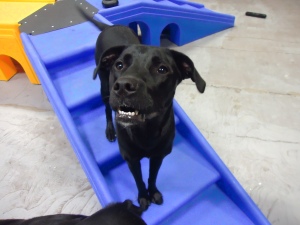 Have you ever wanted to work with dogs for a living?
Have you ever wanted to work with dogs for a living?
Every job has its pros and cons; however, a dog-related career can be rewarding and fun if you choose the one that’s right for you. There are six main categories of dog professions:
Considerations…
The career paths are varied and there are many things to consider before you can start down any one of them. First of all, when you say you want to work with dogs, are you looking for a full time job, supplemental income, a hobby, a change of pace, a volunteer activity for community service or a little bit of everything? Making the right choice for you is complicated. There are practical matters such as aptitude for science or business, educational requirements and, of course, the cost and time involved to complete your training. But if you really love dogs and think you’d like to work with them, do some due diligence and remember the following:
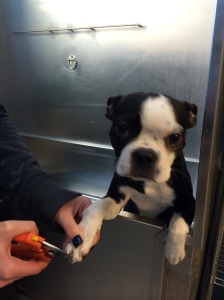
Stay Tuned…
Return to our next blog post for some tips on how to start narrowing the field with practical experience.

If you haven’t made it to the store yet and still plan to pick up your French toast fixings, you are a braver soul than I. We all know that being prepared to make French toast, checking your favorite weather site’s updates hourly in the week leading up to the storm (I’m a Wunderground gal), and daydreaming about all the things you will be able to get done when you can’t leave your house for a week are all key to surviving a shivering squall, but don’t forget to protect your pups too!
Here are some reminders to keep your sweetie(s) safe in this first—and hopefully the last—real PA storm of the season:
Even dogs who generally have no issue with roaming can become easily disoriented in winter weather. Ice and snow drastically weaken their ability to pick up on scents and visual cues to guide them home. Fatigue and anxiety induced by the cold and confusion just make matters worse. If your dog is an adventurer, remember to keep snow piles away from fences because they can provide easy escape routes.
If your pup does wander, having tags—most importantly making sure your dog is wearing them, even if they are so cute naked—significantly improves your chances of a swift reunion. Make sure all the information on the tags is correct and up-to-date.
Remember those microchip registration forms? You maybe have gotten them when your pup was fixed. Did you ever log in and check to make sure the information was complete and correct? Even if your pet loses their collar somewhere along the way, this second line of defense can keep you two from missing each other for longer than necessary.
If my little mutt Otis was a human, he would be a shorts-in-winter bro. My Boxer boy Opie? Not so much. He makes quick work of his business, grumbling all the while, then comes inside and begs to burrow under the blanket I carry around until spring. He even presses his cold paws against me because he can’t stand being chilly—a dog after my own heart.
Just like humans, dogs respond differently to the cold. Dogs’ coats, fat stores, activity level, age, and personality all determine how well equipped they are for cold weather. Dogs in ill health, especially those that have arthritis which can be exacerbated by wet and cold conditions as well as the difficulty of balancing and walking on ice and snow, have a harder time tolerating the cold. Certain conditions like diabetes, heart and kidney disease, and diseases that cause hormonal imbalance can affect a dog’s ability to regulate their body temperature. Whining, shivering, anxiousness, fatigue and burrowing are all signs that it’s time to go inside. Sweaters and coats can help to extend the length of time your dog enjoys being outside. If you have any questions about your dog’s cold tolerance and how it may be affected by any condition, don’t hesitate to ask your veterinarian.
Using a pet friendly ice melt not only will keep your and other dogs safer, but your concrete/brick/stone surfaces, landscaping, children, and the environment will thank you as well!
In this frigid weather, if you see a dog that is being kept outside in insufficient conditions speak up! Bringing attention to the situation can improve the pup’s chances of coming inside. In Pennsylvania, keeping dogs outside is legal as long as they have “access to clean and sanitary shelter which will protect the animal against inclement weather and preserve the animal’s body heat and keep it dry.” Unfortunately this definition is commonly stretched to condone inhumane conditions, but don’t let this silence you. Some people who keep dogs outside simply don’t know the dangers or may just need a little nudge in the right direction. If you feel like a pet’s needs aren’t being met, document the date, time, exact location and photographic/video evidence if possible. Contact local law enforcement or if you are comfortable with the resident, try speaking to them first.
While you may be more than happy to spend your snow day binge-watching Netflix—‘Making a Murderer’ anyone? Your dog may not be as riveted by the possibility of corruption in a high-stakes criminal case. Remember, your sweet pooch can become a little monster act out if they aren’t getting enough exercise and mental stimulation.
A game of treat hide-and-seek is a fun way to keep both you and your dog entertained. Start off by saying, “Find it!” and toss a treat on the floor in front of your dog. Gradually increase this distance and continue to use the “find it” command until you can start hiding treat in increasingly difficult places.
It’s important that your dog also still gets adequate physical exercise. The slippery conditions outside are most definitely a test for your dog’s leash manners. If you find yourself asking “What leash manners?” your pup may be a candidate for Elementary School at the lodge. Just stay safe. A dog without leash manners who pulls can easily cause you to fall and injure yourself. Additionally, it makes releasing the leash much more likely.
If you’re unable to provide enough exercise for your dog or your dog just has a lot of extra energy this winter, daycare is a great way for your dog to socialize, exercise, and stay warm.
One of the easiest and most important things you can do to keep your pooch safe in winter is to wipe down or wash off their paws, legs, and belly after walks. Dogs will likely pick up rock salt and could come in contact with other chemicals like antifreeze during their outing.
When your pup warms up inside, rock salt can burn their paw pads and can cause ulcers and cracks that become infected easily. They may also lick the salt off their feet and suffer similar consequences to their mouth and digestive tract. It only takes a moment to keep your dog safe and save both of you from a vet visit. We use a little tub of water and towel at the door in our mud room, but if your pup is small enough you can just carry them to a tub or sink. Baby or pet wipes are also an easy tool for the job.
Booties are a great way to keep salt and chemicals from touching your pup’s feet in the first place. Some dogs take to booties right away while others dogs face a short adjustment period. If your dog seems to be walking funny at first, don’t give up. Most dogs get the hang of the booties after a few tries and we won’t blame you if you laugh in the meantime.
Here are the reasons it may not be the right time for your new addition…
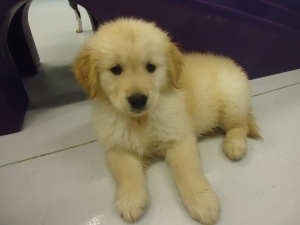 A new pet requires a great deal of time and attention from his new family and the holiday season is crazy enough. In addition to the usual hectic daily routine of school, work and other activities, end-of-year festivities mean even more demands on your time and energy. Extra shopping, cooking and cleaning chores are usually involved, plus trimming the tree, decorating the house, gift wrapping, parties, overnight guests, trips away from home to visit family and friends, and so forth. With all that going on, it’s probably not the best time to introduce a new canine member of the family when everyone is out of their mind with holiday cheer. Dogs don’t get that this is an annual aberration to what their life will be. They will be confused by the multitude of people, the lights, the sounds, and the indoor tree.
A new pet requires a great deal of time and attention from his new family and the holiday season is crazy enough. In addition to the usual hectic daily routine of school, work and other activities, end-of-year festivities mean even more demands on your time and energy. Extra shopping, cooking and cleaning chores are usually involved, plus trimming the tree, decorating the house, gift wrapping, parties, overnight guests, trips away from home to visit family and friends, and so forth. With all that going on, it’s probably not the best time to introduce a new canine member of the family when everyone is out of their mind with holiday cheer. Dogs don’t get that this is an annual aberration to what their life will be. They will be confused by the multitude of people, the lights, the sounds, and the indoor tree.On the other hand, a dog can be a wonderful gift if your family is ready for one…
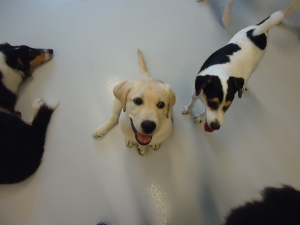
Planning the Surprise
If you’ve thought it through, and you feel that everyone is ready and committed, the surprise can be no dog under the tree Christmas morning! Instead, purchase some equipment like a carrier, leash or bed and place a gift certificate from a shelter with it. Attach a note saying everyone will go together to choose their new pet after the holidays. Before you go, get your family involved in deciding what type, size and breed you’d consider. Read up on which breed’s characteristics might fit in best with your family. Participation in dog training classes is an excellent learning opportunity for everyone. Select a class or two to attend with your new dog.
It’s fun to surprise, but it’s as much fun to be a part of the process. If you subtract Christmas week from the rest of the year, you still have 358 days to bring a new furry loved one into your home and heart. Chances are if you visit a shelter in late January or February, you’ll have your pick of dogs who’ve already worn out their welcome as Christmas gifts.
I never had a dog who didn’t love Christmas morning. The family gathered and playing all in one room, heavenly sounds and scents in the air and best of all, opening and chewing on new toys (their own and everyone else’s).
Do you have an avid chewer or a pup that just loves to play? Why not make him a gift or two from the heart? Often safer, sturdier and more cost-effective than store bought, you can make them in holiday colors or even use a favorite piece of old clothing to make it unique and special to your dog.
 Tennis Ball Buddy
Tennis Ball Buddy
Supplies:
Suggestion: Use towel or denim strips long enough to make tassels at both ends of the ball
Tools:
Cautionary Note: Not every toy is for every dog. These toys tend to be safe when used under supervision. Always keep a sharp eye your pet whenever you’re using any toy, especially for the first time. Discard any small pieces your dog gnaws off before they accidentally swallow them.
Creative Note: Push a few jerky-style treats into the tennis ball before threading the fabric through to make it more enticing. Variation: cover the ball with a sturdy material with tassels sliced into the ends.
